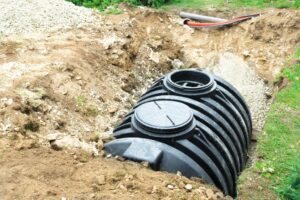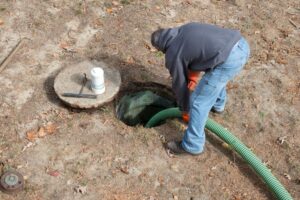A collapsed septic tank is more than an inconvenient breakdown. It’s a serious hazard to your household, health, and property. For residents in Skagit County, including Oak Harbor, Mount Vernon, Stanwood, Burlington, Sedro-Woolley, and surrounding areas, the importance of regular septic tank inspection, pumping, repair, and maintenance services is crucial. Gateway Septic Service, proudly serving the area since 1976, has successfully repaired hundreds of failed systems. In this blog, we offer a comprehensive explanation of what a collapsed tank is, including its effect on waste processing, related health and structural hazards, signs of septic tank failure to observe, and why immediate attention is necessary.
Drawing on our experience, having completed over 1,600 projects with numerous client satisfaction milestones and saving clients hundreds of dollars by avoiding unnecessary pumping, we’ll guide you through determining whether to continue using a damaged system, when to replace a septic tank, or when to call in professional help.
What Does It Mean When a Septic Tank Collapses?
A collapsed septic tank typically refers to a structural failure, such as cracks, sinkholes above the tank, or a full collapse of the tank lid or sidewalls.
This is a rarity, but when a tank is old (with a typical lifespan of 15–20 years) or poorly maintained, the concrete or plastic walls can become weakened. The result? Void spaces develop underground; sludge and liquids may escape into soil or groundwater; piping may settle; and access for septic tank inspection, repair, or maintenance becomes impossible.
Common Causes vs. Consequences of Septic Tank Collapse
| Cause of Septic Tank Collapse | Potential Consequences |
| Tank age (15–20+ years) | Structural weakening, increased risk of wall or lid collapse |
| Poor or irregular maintenance | Sludge buildup, blockages, drain field contamination |
| Improper tank installation or materials | Premature cracks, shifting, or collapse |
| Excessive water usage or flooding | Overload of the system, leach field saturation, accelerated wear |
| Tree roots or soil pressure | Cracks in tank walls or pipes, shifting tank components |
| Heavy vehicles driving over the tank area | Sudden surface collapse, crushed lid or structural elements |
| Use of harsh chemicals | Kills beneficial bacteria, leads to inefficient decomposition and solid buildup |
Statistically, septic tanks older than 20 years carry a 40–50% risk of structural faults or collapse if they are never professionally serviced. This is why Gateway Septic’s repairs often involve replacing risers or full tank replacement.
What Happens to Food Waste in a Septic System?
According to the leading septic tank pumping service experts in Oak Harbor, the septic process relies on anaerobic bacteria to break down solids. Food waste (e.g., fats, oils, and greases, as well as coffee grounds) settles as sludge rather than fully decomposing. Over time:
- The sludge layer grows, pushing solids into the leach field pipes.
- Fats congeal, forming scum layers that reduce bacterial processing.
- If a tank collapses, untreated solids may bypass filtration and contaminate the drain field or groundwater.
- This can cause blockages, backups, and system failure.
Gateway Septic’s regular pumping and cleaning maintenance, which is recommended every 3–5 years, depending on the size of the household, is what prevents such clogging and chain reaction of failures leading to collapse.
Safety and Health Hazards of Utilizing a Faulty Septic Tank
Even the top septic tank cleaning service contractors in Mount Vernon believe that continuing to use a failing or collapsed septic tank system is often fraught with hazards:
Pathogen exposure
Leaching sewage may contaminate wells and groundwater, introducing pathogens such as E. coli, Giardia, or hepatitis A, which pose serious health risks.
Sink or surface collapse
Soil above a weakened tank can collapse—someone could fall, get injured, or suffer more severe consequences.
Odors and gas
Methane and hydrogen sulfide build up in a compromised tank, posing risks of explosion and respiratory hazards.
Structural damage
Advanced collapse may destabilize foundations or landscaping, leading to costly repairs.
Gateway Septic’s past repairs included installing access risers in Stanwood, Burlington, Sedro Woolley, and surrounding areas to improve inspection and septic tank safety, as well as replacing failing tanks before they became a danger of collapse.
Signs Your Septic Tank May Be Failing
Early detection is vital. Watch for these signs of septic tank failure:
- Slow drainage or backups in toilets, sinks, or drains.
- Foul sewage odors around the field or house.
- Wet or lush patches in the drain field (even in dry weather).
- Loud gurgling or bubbling sounds when flushing.
- Cracks, sinkholes, or depressions above where the tank sits.
- Sudden landscaping sink or surface collapse above the tank.
Gateway Septic’s customers in Stanwood, Mount Vernon, Oak Harbor, Burlington, Sedro Woolley, and surrounding areas regularly report these issues, requiring professional septic tank inspection, pumping, repair, and maintenance services. In some cases, a septic inspection revealed that pumping wouldn’t fix the issue, and repairs or replacement were needed instead, often saving clients thousands of dollars in unneeded grade‑A pumping.
Why Immediate Septic Tank Repair Matters?
Ignoring these signs isn’t cost‑effective—it’s risky. Immediate septic tank repair is essential to:
- Prevent system collapse and leaking of untreated waste.
- Avoid the costly replacement of your drain field, which can cost several thousand dollars.
- Stop increased insurance risks and property devaluation.
- Protect your health and avoid well‑water contamination.
Our crew is licensed and community trusted. Our transparent pricing and professional services can help ensure that preventive septic tank repairs are done efficiently.
When to Call a Professional for Septic Tank Inspection?
Prompt professional intervention can make all the difference. You need to arrange a septic tank inspection when:
- You notice any of the signs of septic tank failures above.
- Your tank has reached 15–20 years without professional inspection or pumping.
- You’re buying or selling property in Oak Harbor, Mount Vernon, Burlington, or nearby areas.
- You see soil subsidence, cracks, or disturbance above the tank location.
- Water usage patterns or household size have increased substantially.
A professional septic tank inspection includes reviewing maintenance history, measuring sludge levels, visually inspecting risers and lids, checking field lines, and providing a final report with actionable recommendations. Our team at Gateway Septic does exactly that with thorough and honest evaluation and up‑front estimates.
The Verdict: Don’t Gamble with a Collapsed Septic Tank
Deciding whether it is safe to continue using a collapsed septic tank is simple: it’s not. From structural collapse to health hazards and environmental contamination, the risks are severe and escalating with time. A failing system also damages property value and exposes homeowners to liability. That’s why septic tank safety and septic system maintenance are non‑negotiable.
Gateway Septic Service’s decades-long presence across Skagit County, including Oak Harbor, Mount Vernon, Stanwood, Burlington, Sedro-Woolley, and surrounding areas, backed by over 45 years of experience, 1,600+ completed septic tank pumping, inspection, and cleaning service projects, and transparent pricing, sets the local gold standard.
If you notice any signs of septic tank failure or are wondering when to replace your septic tank, contact us for a septic tank inspection today. Doing so could save you thousands in repair costs, protect your family’s health, and give you peace of mind.
Contact Gateway Septic now at 360-826-5520 to schedule an inspection with our team today. Our courteous expert team will provide you with a full assessment, including recommendations on septic tank repair, pumping, cleaning, maintenance, or replacement. Don’t wait for a collapse. Protect your home and health with proactive septic care.






